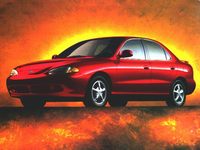New Car Review
SEE ALSO: Hyundai Buyer's Guide
1996 HYUNDAI ELANTRA GLS WAGON
by Tom Hagin
SPECIFICATIONS
Manufacturer's Suggested Retail Price $ 13,799
Price As Tested $ 15,660
Engine Type I4 w/MPI*
Engine Size 109 cid/1795 cc
Horsepower 130 @ 6000 RPM
Torque (lb-ft) 122 @ 5000 RPM
Wheelbase/Width/Length 100.4"/66.9"/175.2
Transmission Four-speed automatic
Curb Weight 2718 pounds
Fuel Capacity 14.5 gallons
Tires (F/R) P195/60R14
Brakes (F/R) Disc/disc
Drive Train Front-engine/front-wheel-drive
Vehicle Type Five-passenger/four-door
Domestic Content 5 percent
Coefficient of Drag (Cd.) N/A
PERFORMANCE
EPA Economy, miles per gallon
city/highway/average 22/31/26
0-60 MPH 9.9 seconds
1/4 mile (E.T.) 16.9 seconds @ 74 mph
Top Speed (Est.) N/A
* Multiport fuel injection
Hyundai is trying hard to erase the unpleasant memories its past vehicles created here and is now tempting buyers with more interior space, more power and an improved ride, all of which should put its new Elantra, available in Base and GLS trim, on the shopping lists of potential subcompact buyers.
Hyundai expects to introduce a new vehicle each year throughout the rest of this century, and this week we evaluate the Korean company's first-ever station wagon, the companion to its completely redesigned Elantra sedan.
OUTSIDE - The new Elantra has been enlarged, albeit only by an inch or so here and there. This newest of Hyundai models is sharply styled, with radically rounded corners and organic shapes. The wagon features a large glass area, which in turn improves outward vision. All models use body-colored bumpers and full wheelcovers, usually an option on other subcompacts, while a large intake scoop down low on its nose provides fresh air for its engine bay. Uplevel GLS models use wider tires than its lesser sibling, while alloy wheels are optional.
INSIDE - Elantra's strong suit is interior roominess, and there is lots of it for such a small car. Smaller engine dimensions have resulted in the need for less room in the engine bay, and all the extra space went inside. Elantra's interior dimensions compare favorably to its competition, and since its driver's seat has a height adjustment, a comfortable driving position is easy to find. Another of its strengths is standard equipment. Items such as a full center console, quartz digital clock, rear window defroster, tilt steering, variable intermittent wipers and remote releases for the fuel filler door and trunk lid are included on both trim levels. GLS trim adds power windows, door locks and outside mirrors, along with a 60/40 split folding rear seat and deluxe carpeting. Special attention has been taken to reduce outside noise, as extensive sound insulation was added to its floor, under-dash area and roof support beams.
ON THE ROAD - Where prior Elantra models relied on Japanese car maker Mitsubishi for powertrains, the new model uses a Hyundai- developed 1.8 liter inline four cylinder engine. The engine, dubbed "Beta" by Hyundai, makes more horsepower than its predecessor, while its healthy 122 lb-ft of torque gives it decent off-the-line acceleration. The new twin-cam engine is smaller and lighter as well, with a narrower cylinder head and weight-saving plastic and aluminum components. The powerful engine is standard equipment on both models, which is something other subcompact makers would do well to emulate. The Beta engine also features a wide torque band, with 90 percent of its torque developing down low at 2300 rpm, a feature most noticed in everyday, around-town driving. A five-speed manual transmission is standard equipment, while a four-speed automatic is available.
BEHIND THE WHEEL - Elantra rides on front MacPherson struts and coil springs, while fully independent suspension replaces the previous model's torsion beam rear axle. All underpinnings are mounted to subframe assemblies, which helps to isolate jarring bumps and road irregularities. A new power rack-and-pinion steering system feels tight and responsive, and its smaller turning radius will help maneuver through tight spots. The standard Elantra braking setup is improved also, with larger vented disc brakes up front and drums in back. GLS models come fitted with rear discs as standard equipment, while a sophisticated four-channel anti-lock braking system is optional. Our test model didn't have ABS, however, but its stopping distances proved above average, with little or no fading. For real-world practicality, we especially liked the wagon's 127 cubic feet of interior volume, in which plenty of cargo can be loaded, and hidden with its standard cargo cover.
SAFETY - Dual airbags and side-impact protection that meets 1997 federal standards are new for 1996, while ABS is optional.
OPTIONS - Air conditioning and cruise control: $1,115; Floor mats: $64; Mud guards: $59; cargo area net: $38; bodyside molding: $75.



